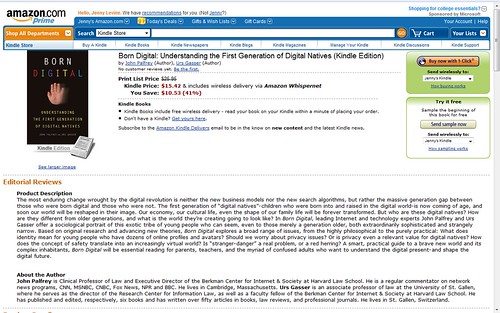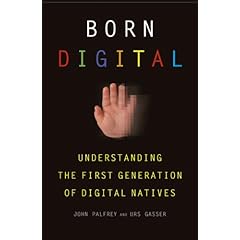(cross posted from John Palfrey’s blog)
The final book in the MIT Press/MacArthur series on Digital Media and Learning (well, final only in terms of my getting around to writing up a review of it on this blog!) is “Digital Media, Youth, and Credibility,” edited by Miriam J. Metzger and Andrew J. Flanagin. It’s not last because it is the least important or least good, but rather it’s the taken the longest time to think about it and its message.
The topic of credibility (and the related themes of information quality and access) is incredibly important — and also very, very hard to get a grip on. It turns out that my co-author on Born Digital, Urs Gasser, is among the world’s experts on this topic in law, so I was in luck. He did most of the research and drafting on our chapters on Quality and Overload. This work also bumps up against what we at the Berkman Center have been struggling with for some time in the context of old and new media and credibility, with our conference on Blogging, Journalism and Credibility and, more recently, the Media Re:Public project.
In their introduction, the editors start out with a summary of each chapter — abstracts, almost — which together serve as a helpful device for those readers who don’t hav the time or inclination to make it through the entire volume. Not suprisingly, the summaries are worthy and faithful to the articles themselves.
Together, the editors have also written a first chapter on opportunities and challenges in the context of online credibility. Their section on “Defining Credibility” and related context (pp. 7 – 9) is useful and could serve as a reference point for other articles on the topic. Their grounding, more generally, of credibility in the youth digital learning environment got me thinking hard about the power of the search algorithms (Google’s PageRank, of course, chief among them) and the impact that these engineering decisions have on what young people are learning and will be learning. A few people in the private sector may never have had such power over a key aspect of learning in history.
The second essay by Metzger and Flanagin also includes “a call to arms to researchers, educators, policy makers, and others concerned with these issues to understand how youth think about credibility in the digital media environment and to devise a plan to assist youth in finding and evaluating the information they need.” (p. 17) Sounds right, but also sounds like a huge challenge.
The summary finding from the editors that grabbed me the most: “Perhaps the most consistent theme across all these stakeholders is that digital technologies complicate traditional notions of hierarchies and authority structures.” (p. 18) Quite right: hierarchies and authority structures don’t go away, they are just shifted around, with new players in the mix. Hierarchy and authority aren’t gone, and won’t go, they’re just different, in ways we are only beginning to understand. (Hence, in my view, the growing importance of librarians and many forms of teachers.)
The book also includes a second “call to arms,” this time in favor of “teaching credibility assessment.” (p. 155) Frances Jacobson Harris notes, quite rightly, that “meaningful access to digital information resources and systems in schools is about much more than a physical connection to the Internet. Digital natives are not necessarily skilled or critical consumers of digital information. Many are still novices when it comes to searching, selecting, and assessing the meaning and value of the information they find.” (p. 155) This is one of the key themes that we explore in Born Digital, and which has previously been built out effectively by Henry Jenkins, Eszter Hargittai, and others. Overall, this essay is totally wonderful: clear, compelling, and with a great conclusion. (pp. 172-3)
David Lankes, in “Trusting the Internet,” offers a nice piece on what he calls “information self-sufficiency” and its implications. It’s well-grounded in the technology and the tools under development on the net. (See especially pp. 115 – 7) I liked this line: “Just like libraries used to produce pathfinders and annotated bibliographies, users will soon be able to find a piece of information, such as a Web site, and follow that information to all of the other public information used in a given conversation.” (p. 114)
One of the sub-themes in the DML series has been the overlay of health and information in the lives of young people. That theme is picked up here in Gunther Eysenbach’s piece on credibility and information related to health online. He introduces and evaluates an interesting model, called DIDA, on the flow of information online. (pp. 132 – 3) The punchline, as one might imagine, is that many people go first to the Internet and second to their doctor for health information today; and there’s still a rich mix of people who consider online information credible and those who are more likely to be skeptical of it (certainly squaring with our own research on young people and digital media, to be sure). (pp. 125 – 6)
Fred Weingarten of the ALA’s Office for Information Technology Policy concludes the volume with a constructive essay on the (limited) role of government in respect to the credibility of information online, which he summarizes into three easy-to-understand categories. (pp. 181 – 2)
So, we are left with two clear calls to arms, some helpful frameworks, and a huge challenge ahead of us. The answer, as unfulfilling as it sounds, has to be to work on critical thinking skills through the schools, libraries, and traditional modes of parenting and peer-learning. Though technology can help, it won’t solve the problems and it may bring about some new problems of its own; I don’t think there will be any short-cuts. But the pay-off of serious engagement on this topic could be enormous in terms of acess to information and new ways of teaching, learning, and engaging in civic life.
Thanks, so much, to the team that Connie Yowell and the MacArthur Foundation and MIT Press put together to develop this series of six books. What a rich resource the collection is, as bound volumes; free downloads; and directions for future research and leadership.









